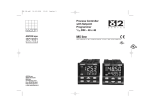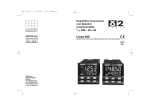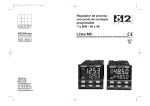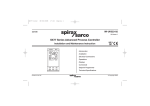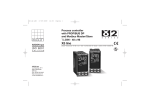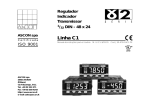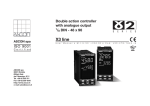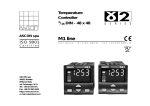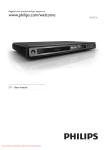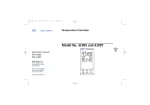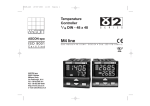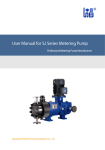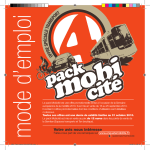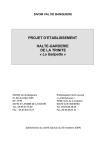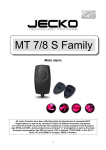Download Manual - Tempatron
Transcript
Process Controller with Setpoint Programmer 1/ 16 DIN - 48 x 48 ASCON spa M5 line ISO 9001 User Manual C e r t i f i e d • c M.I.U.M5-4/03.01 • Cod. J30-478-1AM5 C IE UL LISTED ASCON spa 20021 Bollate (Milano) Italy via Falzarego, 9/11 Tel. +39 02 333 371 Fax +39 02 350 4243 http://www.ascon.it e-mail [email protected] US Process Controller with Setpoint Programmer 1/ 16 DIN - 48 x 48 c M5 line 1 2 3 REM SP 1 RUN SP 2 MAN 48.50 A/M 48.50 Indications c NOTES ON ELECTRIC SAFETY AND ELECTROMAGNETIC COMPATIBILITY Please, read carefully these instructions before proceeding with the installation of the controller. Class II instrument, rear panel mounting. This controller has been designed with compliance to: Regulations on electrical apparatus (appliance, systems and installations) according to the European Community directive 73/23 CEE amended by the European Comunity directive 93/68 CEE and the Regulations on the essential protection requirements in electrical apparatus EN 61010-1 (IEC 1010 - 1) : 90 +A1:92 + A2:95. Regulations on Electromagnetic Compatibility according to the European Community directive n089/336/CEE, amended by the European Community directive n° 92/31/CEE and the following regulations: Regulations on RF emissions EN50081 - 2 for industrial environments Regulation on RF immunity EN500082-2 for industrial equipment and system It is important to understand that it’s responsibility of the installer to ensure the compliance of the regulations on safety requirements and EMC. The device has no user serviceable parts and requires special equipment and specialised engineers. Therefore, a repair can be hardly carried on directly by the user. For this purpose, the manufacturer provides technical assistance and the repair service for its Customers. Please, contact your nearest Agent for further information. All the information and warnings about safety and electromagnetic compatibility are marked with the B sign, at the side of the note. 2 Table of Contents TABLE OF CONTENTS 1 INTRODUCTION....................................................................................................................................PAGE 1.1 PRODUCT CODING.................................................................................................................PAGE 4 5 2 INSTALLATION ........................................................................................................................................PAGE 2.1 DESCRIPTION ...............................................................................................................................PAGE 2.2 OPERATING CONDITIONS ..................................................................................................PAGE 2.3 INSTALLATION ...............................................................................................................................PAGE 6 6 7 7 3 ELECTRICAL CONNECTIONS .......................................................................................PAGE 3.1 TERMINATION UNIT ................................................................................................................PAGE 3.2 CABLING LAYOUT....................................................................................................................PAGE 3.3 ELECTRICAL CONNECTIONS .......................................................................................PAGE 8 8 8 9 4 OPERATIONS .............................................................................................................................................PAGE 4.1 FRONT PANEL..............................................................................................................................PAGE 4.2 CONFIGURATION .......................................................................................................................PAGE 4.3 PARAMETER SETTING .........................................................................................................PAGE 4.4 ACCESS LEVELS ........................................................................................................................PAGE 15 15 16 20 27 5 DISPLAYS.........................................................................................................................................................PAGE 29 6 30 COMMANDS ...............................................................................................................................................PAGE 31 6.1 COMMANDS FROM KEYBOARD ...............................................................................PAGE 33 6.2 COMMANDS FROM DIGITAL INPUTS ................................................................PAGE 6.3 COMMANDS FROM SERIAL COMMUNICATION (PLEASE, REFER THE ADDENDUM ON THE SERIAL COMMUNICATION) 7 SETPOINT PROGRAMMER ( OPTIONAL )..........................................................PAGE 7.1 PROGRAM ORGANISATION ............................................................................................PAGE 7.2 OPERATING CONDITIONS ...............................................................................................PAGE 7.3 PROGRAM INPUT AND EDITING ................................................................................PAGE 7.4 RUN/STOP OF A PROGRAM ........................................................................................PAGE 34 34 36 37 38 8 TECHNICAL SPECIFICATIONS ....................................................................................PAGE 39 3 1 - Introduction 1 INTRODUCTION Congratulations for having chosen these universal controllers. They are the best result of our experience in designing and manufacturing of smart, powerful and high reliable controllers. POWERFUL FEATURES AND A WIDE RANGE OF FUNCTIONALITIES The process controllers of the M5 series have been designed for the industrial environment, are provided with a complete set of functions, as a true universal instrument. They can be used as ControllersProgrammers with 1 Setpoint profile of 16 segments. Operating mode Resources Control Alarms Retransmission Memory Chip Data Copy/Data Store (option) Main universal input PV/SP PV Single 1 action Single 2 action Double 3 action Double 4 action Double 5 action OP1 Auxiliary input (option) AUX Two digital inputs OP2 IL1 IL2 OP3 M5 OP4 6 Valve OP1 OP4 OP1 OP4 Digital inputs (IL1, IL2) functions 4 Parameterisation Supervision (option) One shot Auto tuning OP3 OP4 OP2 OP3 OP4 OP2 OP1 OP3 OP1 OP2 OP3 OP4 Tuning Modbus RS485 OP1 OP2 OP3 OP1 OP2 (option) Setpoint OP2 OP3 OP4 Adaptive 1 - Introduction Line 1.1 PRODUCT CODING Model: The complete code is displayed on the instrument label. M5 The information about product coding are accessible from the front panel by mean of a particular procedure described at section 5.1 pag 29 Instrument label 3150 Hard A/M C B C D – E D Basic product code F G 0 Colour Instruction handbook Setpoint Power Supply 100 - 240V~ (- 15% + 10%) 24V~ (- 25% + 12%) or 24V– (- 15% + 25%) A 3 5 Outputs OP1 (OP2) Relay - Relay Relay - Triac Triac - Relay Triac - Triac B 1 2 4 5 Serial Comms. B A Accessories Power Supply Outputs Serial comm.s/Options P/N ; M5-3150-0000 CONF : S/N : A0A-9809/0011 V~(L-N).85÷264V 50/60 Hz - 3W 1 2 3 REM SP 1 RUN SP 2 MAN Model Basic Options None [2] Auxiliary Input C 0 Feedback potentiometer [2] 0 Remote Setpoint [1] 0 Not fitted Current Transformer 0 SSR drive/analogue Auxiliary 0 Output SSR drive/analogue + Remote Setpoint [1] [2] 0 None [2] 5 RS485 Feedback potentiometer [2] 5 Auxiliary Remote Setpoint [1] Modbus/Jbus 5 Input Current Transformer 5 protocol SSR drive/analogue auxiliary output 5 [1] Not available with Setpoint programmer installed (E = 1) [2] Second digital input (IL2) not available Setpoint Programmer Not fitted Fitted E 0 1 Instruction handbook Italian-English (std) French-English German-English Spanish-English F 0 1 2 3 Front panel Colour Dark (std) Beige D 0 1 2 3 4 5 0 1 2 3 4 G 0 1 5 2 - Installation 2 INSTALLATION 2.1 INSTALLATION DESCRIPTION 2.1.1 DIMENSIONAL DETAILS 48 mm 1.89 in Installation must only be carried out by qualified personnel. IP 20 Termination Unit EN61010 - 1 (IEC1010 - 1) Before proceeding with the installation of this controller, follow the instructions illustrated in this manual and, particularly the installation precautions marked with the B symbol, related to the European Community directive on electrical protection and electromagnetic compatibility. 48 mm 1.89 in 20 mm max 0.79 in max Memory Chip connector Panel surface B To prevent hands or metal touching parts that may be electrically live, the controllers must be installed in an enclosure and/or in a cubicle. 150 mm 5.9 in 2.1.2 PANEL CUT-OUT Product code label 65 mm min 2.56 in min Sealing front panel gasket 45+0.6 mm 1.78+0.023 in Front Panel IP65 protection EN 60529 (IEC 529) 65 mm min 2.56 in min Mounting Clamps 45+0.6 mm 1.78+0.023 in 6 2 - Installation B 2.2 ENVIRONMENTAL RATINGS 2.3 PANEL MOUNTING [1] 2.3.1 INSERT THE INSTRUMENT 2.3.2 INSTALLATION SECURING 1 Prepare panel cut-out 2 Check front panel gasket position 3 Insert the instrument 1 through the cut-out 1 Fit the mounting clamps 2 Push the mounting clamps towards the panel surface to secure the instrument 1 Operating Conditions M T %Rh Altitude up to 2000 m Temperature 0…50°C Relative Humidity 5…95 %Rh non-condensing Suggestions Special Conditions M T %Rh P Altitude > 2000 m Temperature >50°C Use forced air ventilation Humidity > 95 %Rh Warm up Conducting atmosphere Forbidden Conditions C E 3 Use 24V~ supply version Use filters D 2 2 1 2.3.3 CLAMPS REMOVING 2.3.4 INSTRUMENT UNPLUGGING 1 Insert the screwdriver in the clips of the clamps 2 Rotate the screwdriver 1 Push and 2 Pull to remove the instrument Electrostatic discharges can damage the instrument Before removing the instrument the operator must discharge himself to ground Corrosive atmosphere Explosive atmosphere B 1MΩ 1 1 2 1 UL note 2 [1] For Use on a Flat Surface of a Type 2 and Type 3 ‘raintight’ Enclosure. 1 7 3 - Electrical Connections 3 ELECTRICAL CONNECTIONS PRECAUTIONS B Despite the fact that the instrument has been designed to work in an harsh and noisy environmental (level IV of the industrial standard IEC 8014), it is strongly recommended to follow the following suggestions. 3.1 TERMINATION UNIT [1] B 1 7 13 2 8 14 9 15 4 10 16 5 11 17 6 12 18 0,5 Nm 3 5.7 mm 0.22 in Cable size 1 mm2 18 AWG The supply wiring should be routed away from the power cables. Avoid to use electromagnetic contactors, power relays and high power motors nearby. Avoid power units nearby, especially if controlled in phase angle 8 A = Supply B = Relay/Triac Output C = Analog Inputs D = Serial Communication E = Auxiliary Inputs/Outputs F = Digital Inputs A B B A Rear terminal covers A UL note [1] Use 60/70 °C copper (Cu) conductor only. Conduit for supply and output cables B All the wiring must comply with the local regulations. Keep the low level sensor input wires away from the power lines and the output cables. If this is not achievable, use shielded cables on the sensor input, with the shield connected to earth. B 3.2 RECOMMENDED ROUTING OF WIRES 18 screw terminals Option terminals Holding screw 0.5 Nm 1 7 L 13 1 7 L 13 2 8 N 14 2 8 N 14 3 9 15 3 9 15 4 10 16 4 10 16 5 11 17 5 11 17 6 12 18 6 12 18 Positive screw driver PH1 Negative screw driver 0,8 x 4 mm Terminals Ø L Pin connector q 1.4 mm 0.055 in max Fork-shape AMP 165004 Ø 5.5 mm - 0.21 in Stripped wire L 5.5 mm - 0.21 in C E D F C E Conduit for low level sensor cables D F B 3 - Electrical Connections B 3.3 TYPICAL INSTRUMENT WIRING (valve control) mA V 6 A b L 1 14 N 2 15 10 100% 10 16 NO RTD 11 POT 11 17 C B 12 0% 12 18 NO Supervisory OP2 OP1 5 TC 8 C 9 13 CT 3 DIGITAL INPUT OP4 (REM) C 2 4 7 RS485 18 V— OP3 OUT NO 1 Notes: 1] Make sure that the power supply voltage is the same indicated on the instrument. 2] Switch on the power supply only after that all the electrical connections have been completed. 3] In accordance with the safety regulations, the power supply switch shall bring the identification of the relevant instrument. The power supply switch shall be easily accessible from the operator. RS485 Option terminals Digital Input 4] The instrument is PTC protected. In case of failure it is suggested to return the instrument to the manufacturer for repair. 5] To protect the instrument internal circuits use: - 2 A~ T fuses for Relay outputs - 1 A~ T fuses for Triac outputs 6] Relay contacts are already protected with varistors. Only in case of 24 V ~ inductive loads, use model A51-065-30D7 varistors (on request) Commands PLC Alarm Fuse 2A ~T PTC 1 V~ 7 V~ OP3 [6] 2 PV 3 A 2 wires transmitter B 4 8 18V– 9 5 Tc Pt100 16 11 Supply V ~ N N Fuse Positioner module [5] Raise [6] V~ 17 M [6] OP2 12 L 15 C OP1 6 mV-V 14 10 B mA 13 Power switch L Lower 18 Fuse [5] Buffer relays 9 3 - Electrical Connections B 3.3.1 POWER SUPPLY 0.5 AT fuse 13 L 14 N Switching power supply with multiple isolation and internal fuse • Standard version: nominal voltage: 100 - 240V~ (-15% + 10%) Frequency 50/60Hz • Low Voltage version: Nominal voltage: 24V~ (-25% + 12%) Frequency 50/60Hz or 24V– (-15% + 25%) • Power consumption 3 VA max 150Ω/lead maximum 5 6 A For J L T K S R thermocouple type • Use always compensation cable of the correct type for the thermocouple used • Use always compensation cable of the correct type for the thermocouple used • The shield, if present, must be connected to a proper earth. B A 4 b 5 B 6 When using a 2 wire system, put a jumper between terminals 5 and 6 A R1 B 4 For PT100 resistance thermometer • If a 3 wire system is used, use always cables of the same diameter (1mm2 min). 20Ω/lead maximum resistance • If a 2 wire system is used, use always cables of the same diameter (1.5mm2 min). A When the distance between the controller and the sensor is 15 meters, using a cable of 1.5mm2 diameter, produces an error in the measure of 1°C . B1 For ∆T (2x Pt100) • Use wires of the same length 20Ω/lead maximum resistence. 5 R2 A R1 + R2 must be <320Ω 6 10 B 3.3.2 PV CONTROL INPUT 3 - Electrical Connections 3.3.2 PV CONTROL INPUTS (cont.) B 3.3.3 AUXILIARY INPUTS (OPTION) C For DC input Input resistance = 30Ω for mA Input resistance = 10MΩ for mV Input resistance = 10KΩ for Volt 5 5 watt burden resistor 0.5Ω for 1A secondary transformer coil 0.1Ω for 5A secondary transformer coil Rj CT 6 mA 11 load B A For current transformer CT for the measure of the load current • Primary coil 10A…100A • Secondary coil 50 mA default 100mA jumper selectable ~ mV-V 12 50/100mA PV 18V– 3 mA Transmitters C1 For 2 wires transmitters • Power supply to the transmitter 18V– ±10% 30mA max Input resistance = 30Ω 10…100A Option Module for CT 5 Rj 6 Transmitters PV 18V– 3 mA C2 For 3 or 4 wires transmitters • Power supply to the transmitter 18V– ±10% 30mA max Input resistance = 30Ω Jumper for 100 mA secondary transformer coil 5 Rj 6 11 3 - Electrical Connections B 3.3.3 AUXILIARY INPUTS (cont.) e If the analogue input is provided, the terminals for the Remote Setpoint are 10(+) and 9(-) B From Remote Setpoint Current 0/4…20mA Input resistance = 30Ω B 3.3.5 OP1 OP2 OP3 AND OP4 OUTPUTS The functionality associated to each of the OP1 OP2 OP3 and OP4 outputs is defined during the configuration of the instrument. The possible choices are: Control Voltage 1…5V, 0…5V, 0…10V Input resistence = 300KΩ 11 Rj mA C From Position Potentiometer To read the real position of the motor or the valve 1 Single action OP1 Heat 2 Single action OP4 Heat 3 Double action OP1 Heat OP2 Cool 4 Double action OP1 Heat OP4 [1] Cool 5 Double action OP4 [1] Heat OP2 Cool 6 Valve OP1 Raise OP2 Lower 10 100% 100% 11 From 100Ω to 10KΩ max pot.h 0% 12 pot.I Operating Total Travel travel distance distance 0% B 3.3.4 DIGITAL INPUTS Retransm. PV-SP 12 mV-V Alarms OP1 OP2 OP3 OP2 OP3 OP3 OP2 [2] OP1 [2] OP4-C OP4-C OP3 OP3 OP3 OP4-C where: NPN C1 open collector IL 1 15 C2 IL 2 Com. 10 9 Isolated contact 12 TTL open collector • The associated function is active when the digital input is ON (see table on page 33) • The second digital input (IL2) is available only with the following options: Remote Setpoint (D = 2) Current transformer (D = 3) SSR drive / analogue output (D = 4) OP1 - OP2 Relay or Triac output OP3 Relay output OP4 Analogue or SSR drive output OP4-C Analogue output Note [1] In case of OP4 analogue output, its status is not visualised by any red led [2] When the OP4 SSR drive output is selected, the status of OP1 and OP2, as alarms, is not displayed by any red led 3 - Electrical Connections 3.3.5-A SINGLE RELAY OUTPUT (TRIAC) 16 B 3.3.5-B SINGLE SSR DRIVE OUTPUT (OPTION) B Load 17 B Load 11 V~ OP1 3.3.5-F HEAT COOL OUTPUT RELAY (TRIAC)/SSR DRIVE (OPTION) V~ OP4 16 Output 0…22V– ±20% (20mA max) galvanic isolated 3.3.5-C SINGLE ANALOGUE OUTPUT (OPTION) B 3.3.5-D VALVE OUTPUT B 12 OP1 B 17 mA mV,V OP2 galvanic isolated 500 V~/ 1min 750Ω / 15V max if current output 500Ω / 20mA max if voltage output Load 17 OP2 V~ Load 17 18 Load M Lower V~ Cool OP2 ~ 18 3 pole output with NO contacts (raise, lower, stop) B 3.3.5-H HEAT COOL OUTPUT RELAY(TRIAC)/ANALOGUE (OPTION) B 2 NO contacts Heat Cool 18 Heat V~ 12 V~ 3.3.5-E HEAT COOL OUTPUT RELAY/RELAY (TRIAC/TRIAC) OP1 Load OP4 Raise V~ Cool OP4 12 11 16 V~ 3.3.5-G HEAT COOL OUTPUT SSR DRIVE (OPTION)/RELAY (TRIAC) 11 Load Load 11 17 1 NO contact 16 Heat OP1 12 Load 16 Load Heat OP1 11 V~ Cool OP4 17 Load 12 mA mV,V 13 3 - Electrical Connections B 3.3.5-I HEAT COOL OUTPUT DC (OPTION)/RELAY (TRIAC) 11 17 Heat OP4 Load Load Cool OP2 12 3.3.7 RETRANSMISSION OUTPUT (OPTION) 11 V~ Load 18 12 3.3.6 ALARM OUTPUTS OP1, OP2, OP3 Load 16 OP1 17 V~ B e The relay/triac output OP1, OP2 and OP3, can be used as alarm outputs only if they are not used as control outputs. 3.3.8 SERIAL COMMUNICATION (OPTION) 8 Load 2 NO contacts Load 1 V~ OP3 2 1 NO contact 14 9 B • Galvanic isolation 500V~/1 min Compliance to the EIA RS485 standard for Modbus/Jbus 7 OP2 18 galvanic isolated 500 V~/ 1min 750Ω / 15V max if current output 500Ω / 20mA max if voltage output e The analogue/SSR drive output OP4 can be used for signal retransmission only if it is not used as control output. mA mV,V mA mV,V B Common Ground A Please, read: gammadue® and deltadue® controller series serial communication and configuration 4 - Operation 4 OPERATION 4.1.A KEYS FUNCTION AND DISPLAY IN OPERATOR MODE Operating Setpoint (local/remote or stored) PV measure in engineering units Output status LED’s (reds): OP1 output ON OP2 output ON OP3 output ON 5 Status LED’s (green): REM Remote setpoint active SP1 first stored setpoint active SP2 - second stored setpoint active RUN program running MAN manual operating mode 1 2 3 REM SP 1 RUN SP 2 MAN 274.8 275.0 A/M Menu access Automatic/ manual Entry key for selection and value setting confirmation Run/stop Setpoint of a program setting 4.1.B KEYS FUNCTION AND DISPLAY IN PROGRAMMING MODE Parameter value Parameter mnemonic 1 2 3 REM SP 1 RUN SP 2 MAN 35.0 4.1.2 MNEMONIC SETTING (i.e. the modification of the value of a stored Setpoint from 275.0 to 240.0) (Way to modified configuration page 16 / 18) Press $ or % momentarily to change the value of 1 unit every push. Continued pressing of $ or % changes the value, at rate that doubles every second. Releasing the button the rate of change decreases. In any case the change of the value stops when it has reached the max/min limit set for the parameter. Press the $ or % to display the next or previous mnemonic for the selected parameter. Continued pressing of $ or % will display further mnemonics at a rate of one mnemonic every 0.5 sec. The mnemonic displayed at the time the next parameter is selected, is the one stored in the parameter. 1253 2nd stored Setpoint p.b. °C Unit. Centigrade Degrees Engineering Units s.p. 2 °f —lower 1100 2nd stored Setpoint Fahrenheit Degrees Engineering Units Unit s.p. 2 MA —raise 1350 A/M 2nd stored Setpoint mA Engineering Units Unit s.p. 2 Access to the menu for: - configuration - parameter setting - access definition Parameter setting 15 4.1.1 NUMERIC ENTRY Entry key for selection and value setting confirmation The new value is entered when the next parameter is selected by mean of the R key. ph Unit Ph Engineering units 4 - Operation 4.2 CONFIGURATION PROCEDURE Inp Conf 274.8 275.8 Conf Operator Mode Menu é0=10 Press the key until é é sc.lo C.pas sc.Hi High range (linear input only) from sc.lo to max range éno NO YES If the configured hardware option is not installed, the display shows an hardware error message sqr Square root (linear input only) no / yes CHar Linear inputs characterisation no / yes éno énone Analog output not installed Current trasformer not installed Unit Remote Setpoint input not installed Potentiometer input not installed Analogue output + Remote Setpoint not installed Back to the 1st parameter inp.=Conf Setpoint selection see Table 3 Remote Setpoint input (remote input only) see Table 4 éP:Sec Low range (linear input only) from min range up to s.p.tM sc.Hi OK 16 rs.In é9999 If the entered password corresponds to the value set in the parameter C.pas at pag. 27, proceed to YES H.Err rs.p.C é4=20 N° of decimals (linear input only) 0/1/2/3 0 33 from -999 to 9999 (33 as default from the factory) 100 Conf Setpoint Configuration éLoc Input type see table 1 0 sC.dd 100 101 102 103 104 s.p. Configuration menu Inp. Enter the configuration password Inputs Configuration Engineering Units see table 2 Back to the 1st parameter s.p= . Conf Time units and Setpoint slope p.sec/ p.Min / p . hr 4 - Operation CONFIGURATION MENU Out Conf Output Configuration éPid:r L.inP Conf Digital inputs configuration éOFF Conf Alarm s configuration éOFF Il1 IL1 function see Table 8 Il2 IL2 function see Table 8 O.Ity Type of Control see Table 5 H.C.OP Heat control output see Table 6 s.Out Control output safety value Back to the 1st parameter of Off/ -100…100% L.inp=Conf éOFF AlM éOFF Al.1 éOP1 éOFF éOFF AI.Ou AL1 addressing (not available when AL1 is OFF) OpI / Op2/ Op3 ltch AL1 latching (not available when AL1 is OFF) no / yes bloc AL1 start-up disabling (not available when AL1 is OFF) no / yes Al.2 AL2 alarm type see Table 9 A2.Ou AL2 addressing (not available when AL2 is OFF) OpI / Op2/ Op3 ltch AL2 latching (not available when AL2 is OFF) no / yes bloc AL2 start-up disabling (not available when AL2 is OFF) no / yes éno énone rtH é4=20 O.r.ty rt.lo Retransmission low range whole range é0 é9999 rt.Hi C.C.OP Cool control output see Table 7 éOFF éOP1 AL3 latching (not available when AL3 is OFF) no / yes ltch AL3 start-up disabling (not available when AL3 is OFF) no / yes bloc AL4 alarm type see Table 9 éOFF Al.4 AL4 addressing (not available when AL4 is OFF) OpI / Op2/ Op3 éOP1 éno Back to the 1st parameter of Out=Conf A3.Ou éno éno Retransmission high range whole range AL3 addressing (not available when AL3 is OFF) OpI / Op2/ Op3 éno éOFF Retransmission output type (available for DC output only) see Table 4 Al.3 éOP1 éno Retransmission output (available for DC output only) none / pU / s.p. AL3 alarm type see Table 9 AL1 alarm type see Table 9 A4.Ou AL4 latching (not available when AL4 is OFF) no / yes ltch AL4 start-up disabling (not available when AL4 is OFF) no / yes éno 17 4 - Operation EHit Conf Output Configuration Back to operator mode éno bloc é100 Ht.f.C CT High range (available if at least one alarm is Htr) 10…100 éOFF Ht.on Back to the 1st parameter AlM=Conf CT decimal point (available if at least one alarm is Htr) Off / On Tab. 1 Input type Value Description éInp. 32…1112°F tc. j 0…600°C 32…1112°F tc. l 0…600°C 32…2192°F tc. K 0…1200°C 32…2912°F tc. s 0…1600°C 0…1600°C 32…2912°F tc. r -200…400°C -328…752°F tc. t Custom range on request cuSt rtd1 -200…600°C -328…1112°F rtd2 -99.9...300.0°C -99.9…572.0°F del.t -50.0…50.0°C -58.0…122.0°F MU 0…50 mV 0=5 0…5 Volt Engineering 1=5 1…5 Volt 0…10 Volt units 0=10 0…20 mA 0=20 4=20 4…20 mA Tab. 2 Engineering units Value Description éUnit none None °C Centigrade Degrees °f Fahrenheit Degrees MA mA MU mV U Volt bar bar psI PSI rh Rh ph Ph Tab. 3 Setpoint type Value Description érs.p.C. loc Local only reM Remote only l=r Local/remote only loc.t Local - trim reM.t Remote - trim Tab. 4 Rem. Setpoint Retransmission Value Description 0=5 0…5 Volt 1=5 1…5 Volt 0=10 0…10 Volt 0=20 0…20 mA 4=20 4…20 mA Tab. 5 Control type Value Description Of.re Reverse action Of.di Direct action pid.d Direct action pid.r Reverse action U.dir Direct action U.reU Reverse action H.C.ln Linear H.C.Ol Oil charac. H.C.H2 Water charac. érs.In éO.r.ty éOI.ty On - Off P.I.D. Modulating valves Heat/ Cool Tab. 6 Heat control output Value Description éH.C.OP Off Not used rI Relay 1 Digital signal log SSR drive 0=5 0…5 Volt 1=5 1…5 Volt Analogue 0=10 0…10 Volt signal 0=20 0…20 mA 4=20 4…20 mA Tab. 7 Cool control output Value Description éC.C.OP Off not used r2 relay 2 Digital signal log SSR drive 0=5 0…5 Volt 1=5 1…5 Volt Analogue 0=10 0…10 Volt signal 0=20 0…20 mA 4=20 4…20 mA Tab. 8 Digital Inputs function éIl1 Value Description éIl2 Not used Off l=r Local/remote A.Man Auto/manual s.p.1 1st stored Setpoint s.p.2 2nd stored Setpoint keb.I Keypad slo.1 s.p. slope disable H.pU Measure hold r.=H. Run/stop of a program Tab. 9 Alarm type Value Off fs.H fs.l deU.H deU.l band Htr lba éAl1 éAl2 Description éAl3 éAl4 Not used Active high Absolute Active low Active high Deviation Active low Band Out active Heater Break Active high Loop break alarm (Al1 only) 18 4 - Operation 4.2.1 AL1, AL2, AL3, AL4 ALARMS CONFIGURATION It is possible to configure up to 4 alarms: AL1, AL2, AL3, AL4 (see pag. 17), selecting, for each of them: A the type and the operating condition of the alarm (table 9 page 18) B the functionality of the alarm acknowledge (latching) l à tch C the start-up disabling (blocking) b à loc D the physical output of the alarm O à pI O à p2 The range of the alarm threshold correspond to the whole span and it is not limited by the SP Setpoint span. [A] OPERATING CONDITIONS [B] ALARM ACKNOWLEDGE FUNCTION The alarm, once occurred, is presented on the display until to the time of acknowledge. The acknowledge operation consists in pressing any key. yes Absolute alarm On ltch active high O à p3 [D] LOOP BREAK ALARM LBA When the controller connection to the sensor is discontinued or other faults are detected in the control loop, the AL1 alarm becomes active, after a predefined time of 1 to 9999 sec., from the detection of the failure. (see page 22) The alarm state ceases when the fault condition is no longer present. é-fsH Off hyd hyu The outputs can be used for alarms if they are not used as control outputs (see par. 3.3.5 page12) It is possible to route up to 4 alarm to a single output (OR of the alarms). Alarm occurrence display This function can be enabled by the configuration software. (please read the user instruction on the "M5 LINE MODBUS /JBUS PROTOCOL", supplied separately) é-fsl Off low range Alarm threshold 2f.5.H 275.0 A/M SP OP1 yes active high é-deH Off bloc hyd hyu On active low é-del - range Off + range Alarm threshold ∆SP SP Disable ramp down On Off Start-up SP On active out é-bnd Off hyd hyu The red led of the activated alarm output is on. 275.0 Deviation alarm On Ilba [C] START-UP DISABLING Band alarm 1 2 3 1 2 3 high range ∆SP The type of alarm is presented flashing, on the front panel in alternation with the PV value. After this operation, the alarm leaves the alarm state only when the alarm condition is no longer present. On active low ∆SP full scale hyd hyu ∆SP full scale Alarm threshold SP ∆SP Disable On Off Start-up ramp up ∆SP Threshold = SP ± range mA °C e In case of ON-OFF control, the LBA alarm is not active. 19 4 - Operation 4.3 PARAMETER SETTING 274.8 275.8 s.p. Operator mode Menu prog Setpoint menu é loc Menu l=r é 0 s.p. 1 A The parameter setting procedure has a timeout. If no keys are pressed for, at least, 30 seconds, the controller switches back, automatically, to the operator mode. After having selected the parameter or the code, press $ or % to modify the value (see pag 15 and 31) The value is entered when the next parameter is selected, by pressing the è key. Pressing the í key, the operator mode is presented on the display. é sl. u é 1--- é Off sl. d é rtio 2--é 3--- s.sel é éIn:sPcala s.p. l bias éf:sPcala 4--- Remote Setpoint bias (only if local - trim or remote - trim) -span…+span é Setpoint high limit from splto full scale Alarm threshold 4 [2] see table 1 hy.Iu Note [1] The units of the slope parameters are Digit/sec, digit/min. digit/hr, according to the choice defined during the configuration. Alarm threshold 3 [2] see table 0 0 Setpoint low limit from low scale up to spH s.p. H é Alarm threshold 2 [2] see table 0 Ratio Setpoint (only if local trim or remote - trim) -9.99…99.99 énone Stored Setpoint selection (local only) none / s.sp . I . / s.sp . 2 . Alarm threshold 1 [2] see table 0 Slop down (user enabled/disabled) Off/1 digit/…[1] é 1:00 2nd stored Setpoint (local only) full scale Alarm s menu 0 Slope up (user enabled/disabled) Off/1 digit/…[1] Back to the 1st parameter of the Setpoint menu. 20 Menu é Off Setpoint selection local/remote (local or remote configuration only) loc / reM 1st stored Setpoint (local only) full scale 0 s.p. 2 Al Setpoint programmer menu (if the option is installed. see page 37) é 1 hy.Id Alarm 1 hysteresis asymmetric upper 0...span/20 in engineering units Alarm 1 hysteresis asymmetric lower 0...span/20 in engineering units 4 - Operation PARAMETER MENU pId Menu é é 1 é hy.2u 1 é hy.2d 1 é hy.3u 1 é hy.3d 1 é hy.4u 1 hy.4d Alarm 2 hysteresis asymmetric upper 0...span/20 in engineering units Alarm 2 hysteresis asymmetric lower 0...span/20 in engineering units Alarm 3 hysteresis asymmetric upper 0...span/20 in engineering units Alarm 3 hysteresis asymmetric lower 0...span/20 in engineering units Alarm 4 hysteresis asymmetric upper 0...span/20 in engineering units Alarm 4 hysteresis asymmetric lower 0...span/20 in engineering units Back to the 1st parameter of the Alarms menu. Menu 5:0 p.b. é tune PID menu é 12:0 Proportional band (PID algorithm only) 0.1…999.9 % of span t.d. éOFF 60 t.i. Integral time (user enabled/disabled) (PID algorithm only) Off/1…9999 seconds d.Err Absolute Deviation Band full scale Mode Active high Active low Active high Active low Active out of band Load Threshold 1…100A Active high 0.1…20A AL1 activation delay Active high 1…9999 sec O.C. é 50 Mres N° and Param. -fsH -fsl -deH -del -bnd -Htr é 5:0 p.b. C é 60 t.i. C é 12:0 t.d. C Ilba Derivative time (user enabled/disabled) (PID algorithm only) Off/0.1…999.9 seconds é Error dead band 0ff/0.1...10.0 digit é no tune Initial Tune start (one shot tune) no/yes no Adpt Continuous Tune start (adaptive tune) (not available with set prGh) no/yes. Overshoot control (user enabled/disabled) (PID algorithm only) 0.01…1.00 p.b. Calculated Proportional band [3] (display only) (available when adaptive tune is selected) Manual reset (user enabled/disabled) (PID algorithm only) Off/1…100% output t.i. Calculated Integral time [3] (display only) (available when adaptive tune is selected) Proportional band Cool channel (Heat/Cool configuration only) 0.1…999.9% full scale t.d. Calculated derivative time [3] (display only) (available when adaptive tune is selected) é 1:00 Note [2] A code, specifying the n° and the alarm type that has been configured, is displayed. At this point, the user must enter the threshold value, according to the following table. Type and value Tuning menu Cool Integral time (user enabled/disabled) (Heat/Cool configuration only) Off/1…9999 seconds Cool Derivative time (user enabled/disabled) (Heat/Cool configuration only) Off/0.1…999.9 seconds Back to the 1st parameter of the PID menu Back to the 1st parameter Nota [3] These values are not automatically stored on the PID menu parameters P.b.,t.i.,t.d. of the Tuning menu. 21 4 - Operation InP Menu Out Input menu é Off Menu é t.fil é é OP.Hy é 10:.0 Measure bias Off/-60…60 digit t.c. 0:1 t.saM CoMM Menu é 0.0 Sampling time 0.1…10 seconds Op. l é100.0 Op. H Output hysteresis (single parameter in case of ON-OFF control algorithm) 0....5% full scale 0.5 Control Output cycle time (time proportioning only) 0.2…100.0 seconds é tc.C d.bnd Op.CH é 0ff Control output high limit 0…100.0% é Op.rC 60 Control output rate limit (user enabled/disabled) Off/0.01…99.99%/sec. é Off st.Op é Back to the 1st parameter of the input menu 10 st.tM Accs Menu Access menu (see page 27) MU.tM é Control Output soft start value (user enabled/disabled) Off/0.1…100.0% Soft start function activation time (not available if st.Op = Off) 1…9999 seconds é Cool output cycle time (only with Heat/Cool time proportioning) 0.2…100.0 seconds Dead band (only with Heat/Cool config.) 0.0…5.0% é100.0 Control Output low limit (not available in Heat/Cool configuration) 0…100.0% é Off Op.r Serial communication menu é 10:.0 0.5 Filter time constant (user enabled/disabled) Off/0.2…999.9 seconds 0 In.sh Output menu 0.5 MU.hy Back to the 1st parameter of the Output menu Conf Menu Configuration menu (see page 16) 1 Addr Address Off/1…247 é9600 baud Baud rate 1200/ 2400/ 4800 9600/ 19.200 éjbus Cool output high limit (user enabled/disabled) (only with Heat/Cool config.) 0.0…100.0% prot Communication protocol Modb/ jbus Cool output rate limit (user enabled/disabled) (only with Heat/Cool config.) Off/0.01…99.99%/ sec. Motor travel time (only for motorised positioners) 15…600 seconds Minimum output step (only for motorised positioners) 0.1…5.0% Back to the 1st parameter of the Serial Communication menu 22 4 - Operation 4.3.1 PARAMETERS The controller parameters have been organised in group, according to their functionality area. SETPOINT MENU 1st stored Setpoint 2nd stored Setpoint Values of the two Setpoints, that are activated by mean of digital inputs, communication parameters, and keyboard. The Setpoint active is indicated by the â or ä green led. # .p. 1 s #s.p. 2 Setpoint low limit Setpoint high limit High and low limit of the Setpoint SP. The minimum span (sp1-sp2) must be greater than 100 digit. # .p. l s #s.p. H Setpoint ramp up Setpoint ramp down This parameter specifies the maximum rate of change of the Setpoint. Its units are: digit/sec., digit/min. and digit/hour. When the parameter is Off , this function is disabled and the new Setpoint value is reached immediately after being entered (through the keyboard, the digital inputs and the serial communication). Otherwise, the # .l. u s #s.l. d value entered is reached according to the configured rate of change. Remote Setpoint Bias and Ratio Remote signal Remote Setpoint Ratio This parameter defines the maximum span of the Remote Setpoint. r # tio Remote Setpoint Bias It defines the low range of the Remote Setpoint, in engineering units. ab bias = 20 ratio = 0.1 10V a´ b´ bias = 100 ratio = –0.1 #bias. Range -200 LR 0 100 20 b (a´ ) a (b´ ) Remote Setpoint span PV = LR = HR = SR = a (a´) = b (b´) = 600 °C HR Process variable PV low limit PV high limit Remote Setpoint SR starting point SR ending point 23 4 - Operation ALARM MENU (see page 19) If SR starting point is lower then the ending point, both expressed in engineering units: Working Setpoint (SP) as combination of Local Setpoint (SL) and remote signal biaS= starting point = a Setpoint type Loc.t (table 3, page 18) SP = SL + (rtio • REM) + biaS rtio= b-a HR - LR Example: biaS= 20 rtio= 100 - 20 80 = = 0.1 600 - (-200) 800 If SR starting point is higher then the ending point, both expressed in engineering units biaS= starting point = a´ rtio= b´ - a´ HR - LR Example: biaS= 100 rtio= 20 - 100 - 80 = = - 0.1 600 - (-200) 800 24 Setpoint type reM.t (table 3, page 18) SP = REM + (rtio • SL) + biaS SIGN = Remote signal percentage SPAN = HR-LR REM = SIGN * SPAN 100 Examples: Local Setpoint (SL) with an external Trim with multiplying coeff. of 1/10: Setpoint type = Loc.t rtio= 0.1 biaS= 0 Remote Setpoint (SR) with an internal Trim with multiplying coeff. of 1/5: Setpoint type = reM.t rtio= 0.2 biaS= 0 Remote Setpoint range equal to the Input range: Setpoint type = Loc.t rtio = 1 biaS= LR SL = 0 PID MENU # .b. p #p.b. C Proportional Band Cool Proportional Band This parameter specifies the proportional band coefficient that multiplies the error (SP - PV) Integral Time Cool integral Time It is the integral time value, that specifies the time required by the integral term to generate an output equivalent to the proportional term When Off the integral term is not included in the control algorithm. # .i. t #t.i. C Derivative Time Cool Derivative Time It is the derivative term coefficient that specifies the time required by the proportional term P to reach the level of D. When Off the derivative term is not included in the control algorithm. à .d. t #t.d. C 4 - Operation 4.3.1 PARAMETERS (cont.) Overshoot control (Automatically disabled when the adaptive tune is running) This parameter specifies the span of action of the overshoot control. Setting lower values (1—>0.01) the overshoot generated by a Setpoint change is reduced. The overshoot control doesn’t affect the effectiveness of the PID algorithm. Setting 1, the overshoot control is disabled. #O.C. Manual reset This term specifies the value of the control output when PV = SP, in a PD only algorithm (lack of the Integral term). #M.res TUNING Two tuning method are provided: • Initial one shoot Autotuning • Continuous, self learning Adaptive Tuning When the Autotuning is started, the controller generates a rapid burst of ON - OFF transition and monitors the response, in order to calculate the optimal PID terms parameters. Once calculated the terms values are immediately used in the control algorithm. (a minimun error of 5% of span is needed to start the Autotuning) Setpoint change PV variable INPUT MENU Continuous adaptive tune One shot initial autotuning SP #t.fil Perturbation End of the tuning operation and start of control with the new terms values Autotune start Control output The self-learning adaptive autotune, is not intrusive. It doesn’t affect the process, at all, during the phase of calculation of the optimal terms parameters. It is particularly suitable for controlling process whose control characteristics change with time or are not linear in relation to the Setpoint values. It doesn’t require any operation by the user. It is simple and works fine: it samples continuously the process response to the various perturbations, determining the frequency and the amplitude of the signals. On the basis of this data and their statistical values, stored in the instrument, it modifies automatically the PID term parameters. It is the ideal for all applications where it is required to change continuously the PID terms parameters, in order to adjust the PID to the changes of the process dynamic conditions. New parameters In case of power off with the Adaptive Tune enabled, the values of the PID terms parameters are stored, in order to be reused at the next power on. At power on the Adaptive Tune starts automatically. Input filter Time constant, in seconds, of the RC input filter on the PV input. When this parameter is Off the filter is bypassed. Filter reponse 100% 63,2% 0 Filter Time PV Time Measure Bias This value is added to the measured PV input value. Its effect is to shift the whole PV scale of its value (±60 digits). #In.sh Sampling Time Sampling time, in seconds, of the instrument. This parameter is normally used when controlling slow process, increasing the sampling time from 0.1 to 10 seconds. #t.saM. 25 4 - Operation OUTPUT MENU #Op.hy # p.r O #Op.rC Control output hysteresis Heat output maximum rate Cool output maximum rate Heat/Cool deadband This parameter specifies the width of the deadband between the Cool and the Heat channel #d.bnd SP On Off hy Control output hysteresis span, hy, set in % of the full scale. Control output cycle time Cool cycle time It’s the cycle time of the time propotioning control output. The PID control output is provided by the pulse width modulation of the waveform. # .c. t #t.c. C Control Output low limit It specifies the minimum value of the control output signal. It is applied in manual mode, too. #Op. l This value, specified in %/seconds, with range from 0.01 to 99.99%/sec. provides the maximum rate of change of the output. When set to Off this function is disabled. Soft start of the control output It specifies the value at which the control output is set during the start up phase. # p. H O #Op.C.H Heat 100% Heat Cool àOpC.H àOp.H. SP #st.Op Soft start time This value specifies the time the start up phase lasts. The start up phase starts at power up of the controller. #st.tM OP 100% Soft start phase àOp.r Speed in %/sec. àst.Op Control output high limit Cool output high limit It specifies the maximum value the control output can be set. It is applied in manual mode, too. Heat / Cool algorithm Time Start up d.bnd P.b. / C P.b. 0 100% 0 100% Heat output Cool output #MU.tM Travel time Controller address The address range is from 1 to 247 and must be unique for each controller on the communication bus to the supervisor. When set to Off the controller is not communicating A # ddr b # aud Baud rate It provides the baud rate in the range from 1200 to 19.200 bit/sec. P # rot Communication protocol Modb/ jbus It provides the time required to the motor positioner to go from the 0% position to 100% #MU.hy SERIAL COMMUNICATION MENU This Slave protocol allows the supervisor to read and write (when it is possible) all the parameters of the controller. Minimum step It specifies the minimum allowed time of activation of the output to a motor positioner that produces a sensible effect. It is related to the deadband of the positioner ACCESS MENU (see page 27) CONFIGURATION MENU (see page 16) 26 4 - Operation 4.4 ACCESS LEVEL - PASSWORD - CALIBRATION 274.8 275.8 Operator mode Accs Menu II Press until A.pas NO Access menu Enter password for access enable from -999 to 9999 (11 default value from factory) If the password entered corresponds to the one stored in the A.pas [A] parameter, the access configuration page is displayed. OK YES Note Pressing í go back to the Operator mode fUll Ac.le Access to all the levels [1] Oper Execute the following operations C.pas Ac.le Operator level Access Edit Change the Configuration password A.pas Access to the edit level Ac.le [1] With the level of access set to full, all the related parameters are displayed. none EHec yes E.AMn A/M enable / nO EHec 33 C.pas Enter the Configuration password EHec II Change the Access password Enter [A] the Access password A.pas 27 4 - Operation 4.4 ACCESS LEVELS PASSWORD CALIBRATION With the access level Edit, the user defines which groups and parameters are accessible to the operator After selecting and confirming the access level Edit, enter in the parameters menu. The code of the access level is displayed on the front panel. Press the $ and % keys to select the proper level. Group of parameters Code read Hide pId Access level The parameters in the access level Visible fast are recalled on the front panel through the procedure of fast parameter access illustrated in par. 5.2 pag 29. The maximum number of fast parameters is 10. Not visible Menu Parameters 35.0 p.b. Code AItr fast read Hide Access level Visible and changeable Included in “Fast view” Visible only Not visible and not changeable At the end of the parameter list of the selected group, the controller quits from the Edit access level. Therefore, the Edit level must be selected for each group of parameters The access level of groups and parameters, is activated through C.pot EHec load EHec Load the data from Memory chip stor EHec Download the data to Memory chip O potl 255 Confirm and return back to the Operator mode 28 potH Calibrate the potentiometer (if present) Oper Ac.le The valve go to low scale When the indication (the valve) is stopped, confirm the calibration value using $ or % The valve go to full scale Confirm Access level operator 5 - Displays 5 DISPLAYS Manual mode 274.8 MAN 5.1 STANDARD DISPLAY 5.2 FAST VIEW (fast access to the parameters) 274.8 Operator mode 275.8 Automatic mode 275.0 274.8 Engineering units °C 63.0 SW release and first part of instrument code (HW) 00A OP1 output value (not displayed if ON-Off) no One shot tune start no/yes tune 300.0 Software release t.s.p. Target Setpoint value local mode only (not displayed if the Slopes are disabled) 365.8 3fs.H 50 A B C D Hard Example of common parameters included in the fast view (fast access) Op rel. 3150 With this procedure, simple and fast, up to 10 parameters, selected through the fast view (see par 4.4 page 28) are displayed and can be modified by the operator without requiring the standard parameter setting procedure. Press $% in order to modify the parameters The value is entered by pressing è key t.Cur Base product code (see page 5) Back to the Operator mode Alarm 3 threshold (high absolute alarm) full scale Load current in Ampere (CT option only) none s.sel Stored Setpoint selection none/s.sp . I . /s.sp . 2 . Back to the operator mode 29 6 - Commands 6 COMMANDS COMMANDS TO THE CONTROLLER AND OPERATING PHASES The commands can be entered in 3 ways: 1 2 3 REM SP 1 RUN SP 2 MAN 48.50 48.50 A/M 6.1 KEYBOARD • • • • • • 30 Setpoint modification (page 31) local/remote selection (page 31) stored Setpoint display (page 31) manual mode (page 32) tuning start (page 32) programmer stop (page 38) 6.2 DIGITAL INPUTS see page 33 6.3 SERIAL COMMUNICATIONS see the manual on this topic 6 - Commands 6.1 KEYBOARD COMMANDS A. SETPOINT MODIFICATION The Setpoint is directly modified with the $% keys. Once entered, the new value is checked and becomes operating after 2 seconds.. The end of this phase is flagged by flashing momentarily the display with SP. 274.8 Operator mode 275.0 B. LOCAL/REMOTE 274.8 Modified Setpoint value 350.0 s.p. Operator mode 275.0 Menu Local/remote selection loc 350.0 Flash momentarily the SP value to confirm that it has become operating. back to the operator mode The Setpoint is directly modified with the $% keys. Once entered, the new value is checked and becomes operating after 2 seconds.. This phase is flagged by flashing momentarily the display with SP. Select remote reM Select local loc Stored Setpoint display l=r l=r after 2 seconds 274.8 Setpoint menu Press until Example of Setpoint modification from 275 to 350 274.8 C. STORED SETPOINTS SELECTION The selected Setpoint becomes operating pressing the è key. when in remote, the green led is on Ü 2nd stored Setpoint l=r Back to the operator mode Note: When the Setpoint value is changed, the entered value is reached with a maximum rate set by the ramp up s à l u . and ramp down, s à l. d parameter. This applies to all the models and in all the operating modes. It is suggested to set s à l. u and s à l. d to Offwhen the remote Setpoint is operating. The entered Setpoint is defined as target Setpoint. It is displayed in the function menu at the parameter t.=s.p. If the slope parameter is set to zero the Setpoint variation occurs instantaneously. 1st stored Setpoint none s.sel s.s.p.1 s.sel s.s.p.2 The selected Setpoint becomes operating pressing the è key. The two âä leds flag the Setpoint operating. s.sel Back to the operator mode Example Target Setpoint = 350°C Setpoint change s à I. u = 10 digit/minutes Initial Setpoint = 250°C t t = 10 minutes 31 6 - Commands 6.1.2 AUTO/MANUAL MODE 274.8 MAN 275.0 274.8 MAN 50.0 6.1.3 TUNING This controller is provided with 2 different Tuning algorithm Operator mode (automatic) • One shot tune for calculating the optimal PID terms parameters. 274.8 tune 275.0 Menu press until Select manual green { led on press until Continuous tune (adaptive tune) One shot tune 274.8 MAN 35.0 Modify the output value Confirm yes Back to the operator mode to start AUTO 100% Setpoint SP MAN AUTO SP SP (PV) PV 32 Confirm no to stop no no tune Adpt yes tune no The command start/stop is executed pressing the è key. When the controller is calculating the PID terms parameters, the { led is flashing tune Confirm yes to start (Not present with programmed Setpoint) yes tune The command start/stop is executed pressing the è Confirm no to stop no key. tune Op.r SP = PV 0 100%output OP OPMAN=OPAUTO change OP OP OP co 0 • Continuous tuning (adaptive tune) for a continuous calculation of the PID terms parameters in order to adapt the control to dynamically changing process or not linear ones. ST Y OPAUTO=OPMAN After the execution of the tuning, the calculated values are automatically presented in the PID menu. When this function is in progress, the calculated values are visible in the Tuning menu but cannot be modified. (see page 21) 6 - Commands 6.2 DIGITAL INPUT COMMANDS Function Performed operation Note Off On n à one — — Set manual mode àA.Man Automatic Manual Keypad lock àKeb.I Unlock Locked PV measure hold àH.pU Normal operation PV is hold The value of PV is “frozen” at the time the digital input goes to the close state Setpoint slopes inhibition àslo.1 Rate limiting is active Normal operation When the input is in the on state, the Setpoint is changed in steps Standard Setpoint None Programmed Setpoint A function is assigned, through the configuration procedure to each IL1 and IL2 digital input. (see the parameters setting at tab 8 at pag 17). The configured function is activated when the digital input (free voltage contact or open collector output) is in the On state . It is deactivated by setting the input to the Off state. The activation of the function through the digital input has the highest priority than through the keyboard or through the serial communication. Parameter value 1st stored Setpoint àsp.1 Local 1st SP 2nd stored Setpoint àsp.2 Local 2nd SP Remote Setpoint àl=r. Local Remote Start/stop of a program àH.=r. Hold/Run Not used With the keypad locked the commands from digital inputs and serial communication are still operating If more than one digital input is selecting a Setpoint, the last to be activated is the one operating. The status (RUN/HOLD) changes every time the digital input switches from Off to On. 33 7 - Programmed Setpoint 7 PROGRAMMED SETPOINT INTRODUCTION 7.1 The controller supplied with the Setpoint programmer option (mod. M5-3… &) offers, in alternative to the adaptive tuning, the functionality to define, store, display and execute a program consisting in the Setpoint profile in time. The program consists of a sequence of segments. MAIN CHARACTERISTICS • 1 program, 16 segments/program • start, stop, hold etc, commands from the keyboard • time base in seconds, minutes or hours • continuous or up to 1…9999 time cycling of the program • 1 OP3 digital output with the state profile defined by the program • setting of the maximum allowed deviation from the Setpoint PROGRAM STRUCTURE For each segment, it is specified: • the Setpoint to reach às.p. always • the duration present of the segment àt.i. • the state of the OP3 output Normal segments These segments build up the profile program. There are 3 types of segments: Ramp àsp.== The program consists of: • 1 initial segment named O • 1 end segment named f • 1…14 normal segments àti.== Dwell àsp== àsp.== àti.== àti== Step Initial segment Its main purpose is to define the value the process variable has to maintain before starting the program. àsp.== àti.== = 0 End segment Its main purpose is to define the value the process variable has to maintain at the end of the program and until further changes of Setpoint. 34 s.p. ti. = Target setpoint = Duration = Previous segment = Current segment = Next segment 7 - Programmed Setpoint EXAMPLE OF SETPOINT PROFILE °C àsp. 4 Setpoint àsp. 9 àsp.10 Maximum allowed deviation àsp. 3 àsp.11 band àsp. 2 350 àsp.12 300 250 àsp.13 Program start àsp. I àsp.14 200 150 àsp. f 100 àsp. 0 50 0 30 50 Segment Initial Time OP3 Digital Output t0 70 80 110 170 190 210 230 250 1° 2° 3° 4° 5° 9° 10° 11°/12° 13° 14° t1 t2 t3 t4 t5 t9 t10 t11/t12 t13 t14 time End The OP3 digital output state, during the segments, is defined in the program àCIo C à Io contact close (On) àOpn O à pn contact open (Off) 35 7 - Programmed Setpoint 7.2 SETPOINT PROGRAMMER OPERATION 7.2.1 MAXIMUM ALLOWED DEVIATION ( band ) If the PV controlled input value exceeds the band, centred around the SP, the segment time is extended of the same time the PV input stays out of the band. The band width is defined in a parameter of the program segment. The actual segment period is calculated as ti.= . = +Ti A. Ramp àband àband SP 7.2.2 RE-START OF A PROGRAM AFTER A POWER FAILURE The parameter #fail . specifies the behaviour of the programmer at power up (see pag.37). Selected between the following 3 choices: # ont is selected, If C the execution of the program starts from the point reached at the power failure time. C # ont Continue r # es Reset All the parameters, like Setpoint and the remaining time are restored at the values they had at power off. r # aMp Ramp The drawing below illustrates the situation. Power off during a dwell Power Off SP Power Off PV Power off during a ramp ti Power Off time PV Ti àti.-àti.-- + Ti If r # es is selected, at power on the program ends and goes back to local mode. B. Dwell SP àband àband PV Ti àti.-ti.-- + Ti 36 If r # aMp is selected, the execution of the program starts from the point reached at the power failure time. In this case, the programs continue with PV reaching SV with a ramp, whose slope corresponds to the one of the segment running at the power off. Power Off ti 7 - Programmed Setpoint 7.3 CREATION AND MODIFICATION OF A PROG. 274.8 275.8 Operator mode prog Menu Program menu (if present) PARAMETER MENU stat Program status res = reset Hold = hold run = start ti. O Segment 0 time 0.1…999.9 Unit sp. f End segment Setpoint whole range fail Restart after a power off Cont = continue res = reset raMp = continue with the slope sp. 0 Segment 0 Setpoint whole range dO. f End segment digital output[1] Clo = closed Opn = open Off = inhibited dO. O Segment 0 Digital output [1] Clo = closed Opn = open Off = inhibited ti. I Segment 1 time 0.1…999.9 Unit Unit Time units p.sec = seconds p.Min = minutes p.hr = hours n.seg N° of segments 1…14 max Cyc. N° of program cycles Off / 1…9999 band Allowed deviation Off / 0…span/20 Continue for all the 14 normal segments sp. 1 [1] One digital output is provided which can be controlled by the program. This output is OP3. If this functionality is not required, it can be inhibited by setting Off the parameter d à O . . - Back to the 1st parameter Segment 1 Setpoint Intera scala dO. I Segment 1 Digital output [1] 37 7 - Programmed Setpoint 7.4 START/STOP OF A PROGRAM DIRECT MODE WITH The various commands, supported by the controller, are different for each of the following operating phases: A] when in Local Setpoint mode B] during the execution of a program C]when the program is in hold THROUGH THE PARAMETER MENU PARAMETER MENU 274.8 275.0 Commands supported by the controllers Operator mode (local Setpoint) Phase Supported commands Program menu Menu Press until Program start Type of operating setpoint prog Local Programmed Programmed Start of a program Execution of a program Hold of a program A B C run stat 274.8 RUN 275.0 Program running Ö led continuously on Setting of Local setpoint Program start Hold Program start Program hold Program continuation Program stop in local mode Program stop in local mode Program stop in local mode stat Program Hold When the program is ended it comes back to normal mode Program hold 329.0 RUN 333.0 Program hold Ö led flashing res stat The different phase are displayed in a chained way, just for easing the understanding of the functionality. Two different mode for starting and stopping a program are provided: direct mode with the ê key through the parameter menu 38 Continue up to the program end Program reset A The Ö green led is flashed at high rate when the controlled variable is out of the allowed deviation band The current time of a segment is hold up to the time the variable re-enter in the band. 8 - Technical Specifications 8 TECHNICAL SPECIFICATIONS Features Description at 25 °C env. temp. Total The choices are: input type, operating mode, type of control, safety strategies, alarm strategies configurability 1 loop with single/double output Operating modes 1 loop as the latter with the addition of the Setpoint programmer PID with overshoot control or On-off Algorithm PID with velocity algorithm, for controlling motorised positioners Proportional band (P) 0.1…999.9% Integral time (I) 1…9999 sec. Derivative time (D) 0.1…999.9 sec. (user enabled/disabled) Error band 0.1…10.0 digit Manual reset 1…100% output (user enabled/disabled) Cycle time 0.2…100.0 sec. Hysteresis 0.1…5.0% Control mode Dead band 0.0…5.0% Cool proportional band 0.1…999.9% Cool Integral time 1…9999 sec. (user enabled/disabled) Cool Derivative time 0.1…999.9 sec. Cool cycle time 0.2…100.0 sec. Motor travel time 15…600 sec. Motor minimum step 0.1…5.0% Feedback potentiometer 100Ω…10KΩ Common PV input characteristics (see table 1 page 18 for the signal ranges) Accuracy PID control Time proportioning control Discontinuous control ON-Off control Heat/Cool control Motorised positioner A/D converter with resolution of 160.000 points Update measurement time: 50 ms Sampling time (max update time of the output) : 0.1…10.0 sec. configurable Input bias: - 60…+ 60 digit Input filter with enable/disable 0.1…999.9 sec. 0.25% ± 1 digits for temperature sensors 0.1% ± 1 digits (for mV and mA) Between 100…240V~ the error is minimal 39 8 - Technical Specifications Features Description at 25 °C env. temp. PV input Resistance thermometer (for ∆T: R1+ R2 must be <320Ω) Pt100Ω a 0°C (IEC 751) °C/°F selectable 2 or 3 wires or 2 Pt100 for ∆T Max. wire res.: 20Ω (3 wires) Input drift 0.1°C/10°C Env. temperature <0.1°C/10Ω Wire Resistance Thermocouple L,J,T,K,R,S (IEC 548) °C/°F selectable Internal cold junction compensation Max. wire res.: 150Ω Input drift <2µV/°C Env. temperature <5µV/10Ω Wire Resistance DC input (current) 0/4…20mA Rj = 30Ω Engineering units Configurable decimal point position – with or without √ Initial scale.: - 999…9999 Full scale.: -999…9999 (minimum range of 100 digits) Input drift <0.1% / 20°C Env. Temp. <5µV / 10Ω Wire Res. DC input (voltage) Auxiliary inputs (options) Digital inputs Control output (cont.) 40 Remote Setpoint Not isolated accuracy 0.1% 0…50 mV Rj = 10MΩ 1-5/0-5/0-10V Rj = 10KΩ Current 0/4…20mA Rj = 30Ω Bias in engineering units and ± range Voltage 1-5/ 0-5/ 0-10V Rj = 300KΩ Ratio from -9.99…+99.99 CT current transformer max span 50 or 100 mA hdw selectable Display from 10 to 200 A resolution of 1A with alarm threshold (Heater break alarm) Potentiometer 100Ω…10KΩ supply 300mV Position feedback measurement Local + Remote Setpoint Auto/Man mode change, Local/Remote Setpoint mode change, Stored The closure of the external Setpoints activation, keypad lock, measure hold and slopes inhibit. 2 logic contact produces any of the Start, stop, hold of a program following actions: (only with Setpoint programmer) Single or double channel, direct or reverse action Minimum limit 0…100.0% (OP1 heat) Maximum limit 0…100.0% (OP1 heat), -100.0…0% (OP2 cool) 8 - Technical Specifications Features Description at 25 °C env. temp. Maximum slope Safety value Time proportioning Control output Analogue Motor positioner (3 states) Raise - Stop - Lower 0.01…99.99%/sec. up and down -100…100% . (user enabled/disabled) Relays NO 2A/250V~ resistive loads Triac 1A/250V~ resistive loads 0…22V–, 20mA max SSR drive (for static switches) Current 0/4…20mA max 750Ω/10V max 0…1/5/10V Voltage 500Ω / 20mA max Double action 2 poles NO, 2A/250V~ resistive load Galvanic insulation 500V~/1min. Resol.: 12 bit (0.025%) Accur. 0.1%. Short circuit protection SPST NO, 2A/250V~ resistive load Hysteresis 0.1…5.0% symmetrical Active high Action type Active low Alarms Actions Special functions OP4 analogue output (optional) Galvanic insulated: 500 V~/1min. Resolution: 12 bit (0.025%) Accuracy: 0.1% . Short circuit protected Setpoint Ramp up and down, with slope in digit/sec., digit/minute or digit/hour between 0.0…10.0% of the range High and low limits Deviation threshold ± range Band width 0…range Absolute threshold Heater Break detection Loop Break Alarm Activation inhibit (blocking) Acknowledge (latching) Related to the program (optional) (OP3) Current 0/4…20mA 750Ω/10V max Voltage 1-5/0-5/0-10V 500Ω/20mA max Local plus 2 stored Setpoints Only Remote Local and Remote Local with trim Remote with trim Time programmable (optional) Whole scale Retransmission of PV or SP 41 8 - Technical Specifications Features Description at 25 °C env. temp. 1 program, 16 segments (1 initial and 1 end) Programmable From 1 to 9999 cycles or continuous cycling (Off) Setpoint Time values in seconds, minutes and hours (optional) Start, stop, hold, etc. activated from the keyboard, digital input and serial communications. One shot Tune- step response method for calculating the PID terms parameters Tuning Auto/Manual station Serial com. (optional) Auxil. supply Operational safety Adaptive Tune self-learning, not intrusive, analysis of the process response to perturbations and continuously calculation of the PID parameters (not available with the Setpoint Programmer option) Integrated in the controller, bumpless Operated from keyboard, digital input and serial communication. RS485 isolated, Modbus-Jbus, 1200, 2400, 4800, 9600, 19200 bit/sec., 2 wires 18V– ± 20%, 30mA max for transmitters (2, 3, 4 wires) Measure Detection of out of range, short circuit or sensor break with automatic activation of the safety strategies and input alerts on display Control output Safety value: -100…+100%. (user enabled/disabled) Parameters Parameters and configuration data are stored in a non volatile memory for an unlimited time. They are organised in functionally homogeneous groups, like: visible and changeable, visible and not changeable, not visible. Access protection Password to access the configuration data and the parameter protection menu 100 - 240V~ (- 15% + 10%) 50/60Hz or 24V~ (- 25% + 12%) 50/60Hz and 24V– (- 15% + 25%) power consumption 3W max Electric safety Compliance to EN61010, installation class 2 (2500V) pollution class 2 General Electromagnetic compatibility Compliance to the CE standards for industrial system and equipment characteristics UL and cUL Omologation File E176452 Protection EN650529 IP20 termination unit, IP65 front panel 1/ DIN - 48 x 48, depth 150 mm, weight 230 gr. apx. Dimensions 16 Supply 42 G.&P. Grafica & Pubblicità • Gazzaniga (BG) • e-mail: G & P @ m a i l - g a t e . net Warranty 1 WARRANTY We warrant that the products will be free from defects in material and workmanship for 3 years from the date of delivery. The warranty above shall not apply for any failure caused by the use of the product not in line with the instructions reported on this manual. 43 ASCON’S WORLDWIDE SALES NETWORK SUBSIDIARY DISTRIBUTORS FRANCE ARGENTINA PORTUGAL ASCON FRANCE Phone 0033 1 64 30 62 62 Fax 0033 1 64 30 84 98 MEDITECNA S.R.L. Phone +5411 4585 7005 Fax +5411 4585 3434 REGIQUIPAMENTOS LDA Phone +351 21 989 0738 Fax +351 21 989 0739 AGENCE SUD-EST Phone 0033 4 74 27 82 81 Fax 0033 4 74 27 81 71 AUSTRALIA SPAIN IPA INDUSTRIAL PYROMETER (AUST) PYV.LTD Phone +61 8 8352 3688 Fax +61 8 8352 2873 INTERBIL S.L. Phone +34 94 453 50 78 Fax +34 94 453 51 45 BRANCH OFFICE Phone +34 93 311 98 11 Fax +34 93 311 93 65 Phone +34 91 656 04 71 Fax +34 91 677 21 26 FINLAND & ESTONIA TIM-TOOL OY Phone +358 50 501 2000 Fax +358 9 50 55 144 SWITZERLAND GERMANY MESA INDUSTRIE ELEKTRONIK GMBH Phone +49 2365 915 220 Fax +49 2365 915 225 CONTROLTHERM GMBH Phone +41 1 954 37 77 Fax +41 1 954 37 78 TURKEY GREECE CONTROL SYSTEM Phone +30 31 521 055-6 Fax +30 31 515 495 BRANCH OFFICE Phone +30 1 646 6276 Fax +30 1 646 6862 HOLLAND HSD INSTRUMENTS Phone +31 78 617 03 55 Fax +31 78 618 26 68 KONTROL SISTEMLERI LTD Phone +90 216 302 19 70-71 Fax +90 216 302 19 72 UNITED KINGDOM EUKERO CONTROLS LTD Phone +44 20 8568 4664 Fax +44 20 8568 4115













































